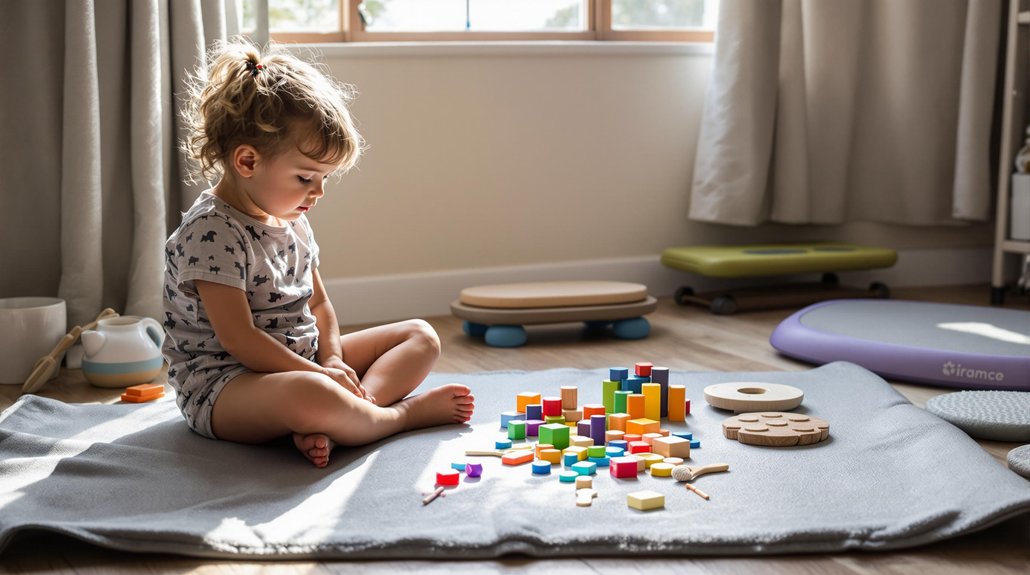Your typical occupational therapy (OT) session will last between 30 to 60 minutes, with the exact duration depending on your treatment setting and individual needs. School-based sessions often run 30 minutes, while hospital visits may extend to an hour. Children usually have shorter sessions, while adults might need longer treatment times. Your age, attention span, and therapy goals all play important roles in determining your ideal session length. Understanding these factors can help you make the most of your OT treatment.
Standard Duration Ranges for OT Sessions
While OT session lengths can vary based on individual needs, most outpatient occupational therapy appointments last between 30 to 60 minutes. Your therapist will determine the ideal duration based on your specific condition, goals, and stamina level.
You’ll find that session variability is common in different settings. School-based OT typically offers 30-minute sessions, while hospital-based therapy might extend to 45-60 minutes.
For pediatric clients, shorter 30-minute sessions often prove most effective due to attention spans and energy levels.
Treatment effectiveness depends on selecting the right session length. If you’re recovering from a significant injury or managing a complex condition, you might benefit from longer sessions.
Similar to home health therapy, sessions may occur several times per week initially and decrease in frequency as you show improvement.
Your therapist will adjust the duration to guarantee you’re making progress without becoming overly fatigued.
Factors That Influence Session Length
Several key factors determine the length of your occupational therapy sessions. Your client’s needs and attention span play a significant role, as some individuals may require shorter sessions to maintain focus and engagement.
The complexity of therapy goals also impacts duration, with more challenging objectives often demanding longer sessions for effective practice and skill development.
Insurance coverage and reimbursement policies can affect how long you’ll spend with each client, as some plans specify maximum session lengths.
The client’s age group matters too, with pediatric sessions typically running shorter than adult treatments.
Additionally, the type of intervention you’re providing influences timing – physical rehabilitation might require more extended periods than cognitive exercises.
Your clinical setting also shapes session length, as hospital-based treatments may differ from outpatient care durations.
Physical therapy at home allows for more flexible session lengths that can be customized to each patient’s recovery needs and comfort level.
Age-Specific Session Timeframes
Different age groups have distinct ideal session lengths in occupational therapy. You’ll find that toddler sessions typically run shorter due to limited attention spans, while adolescent sessions can extend longer as teens show more endurance and complex treatment needs.
| Age Group | Typical Session Duration |
|---|---|
| Toddlers (1-3) | 30-45 minutes |
| Children (4-12) | 45-60 minutes |
| Adolescents (13+) | 60-90 minutes |
When you’re working with young children, you’ll want to keep sessions engaging and brief to maintain their focus. As your clients age, you can gradually increase session duration to accommodate more sophisticated interventions and goals. Remember to watch for signs of fatigue or diminishing returns, regardless of the standard timeframes for each age group. Focus Family Care provides certified occupational therapists who deliver these age-appropriate sessions directly in your home.
Insurance Coverage and Session Duration
Insurance policies typically dictate the length and frequency of occupational therapy sessions you’re allowed to receive. Most insurance providers approve 30-60 minute sessions, though the specific duration depends on your plan’s coverage and medical necessity.
You’ll find that insurance policies often set limits on the number of sessions they’ll cover within a specific time frame. Before starting therapy, it’s crucial to verify your coverage details and session reimbursement rates. Your occupational therapist can help you navigate these requirements and may adjust session lengths to maximize your approved benefits.
If you need additional therapy beyond what your insurance covers, you can discuss alternative payment options or modified treatment schedules with your provider to guarantee you receive the care you need while managing costs effectively. Similar to Medicaid home health care, therapy services can be tailored to meet individual needs while maintaining cost-effectiveness for families.
Signs Your Session Length Should Be Adjusted
Recognizing when your OT session length needs adjustment can help maximize your therapy’s effectiveness.
As a healthcare provider, you’ll want to monitor your client’s progress and be responsive to their needs. Session effectiveness often depends on finding the right duration that allows for meaningful progress while maintaining client engagement.
Watch for these key indicators that suggest you should adjust your session length:
- Your client consistently shows signs of fatigue or loss of focus before the session ends, indicating a need for shorter sessions
- You’re routinely unable to complete planned therapeutic activities within the allotted time, suggesting longer sessions may be beneficial
- Client feedback indicates that the current session length isn’t meeting their goals or fitting their schedule
Remember to document these observations to support your recommendations for timing adjustments.
Working with licensed professionals through skilled home care services can help ensure optimal session lengths that promote independence and recovery in a familiar environment.
Maximizing Your OT Session Time
Making the most of your OT session time requires thoughtful planning and efficient execution. To achieve ideal session efficiency, you’ll want to prepare materials in advance and maintain clear communication with your client. Focus on creating an environment that promotes client engagement and meaningful progress.
| Time-Saving Strategy | Implementation Tips |
|---|---|
| Pre-session prep | Organize materials and workspace |
| Goal tracking | Use digital tools or quick charts |
| Activity shifts | Plan smooth movement between tasks |
| Documentation | Take notes during natural breaks |
You can enhance your session’s effectiveness by establishing routines that maximize hands-on therapy time. Remember to regularly check in with your client’s energy levels and adjust activities accordingly. When you structure your sessions thoughtfully, you’ll create more opportunities for meaningful therapeutic interactions and better outcomes.
Conclusion
OT sessions typically range from 30 minutes to one hour, depending on your personal needs and goals. Think of each session as building blocks – some days you might need a shorter session to work on specific skills, while other days may require more time to master new techniques. Your therapist will work with you to find the perfect timing that helps you make steady progress and feel comfortable.
You deserve care that fits your life, and we’re here to make that happen. Just like every person is unique, your OT journey is your own. We’ll be right beside you, adjusting and supporting you every step of the way.
Don’t walk this path alone. If you or a loved one need help, don’t wait. Reach out to Focus Family Care today at (561) 693-1311 or email us at info@focusfamilycare.com.





